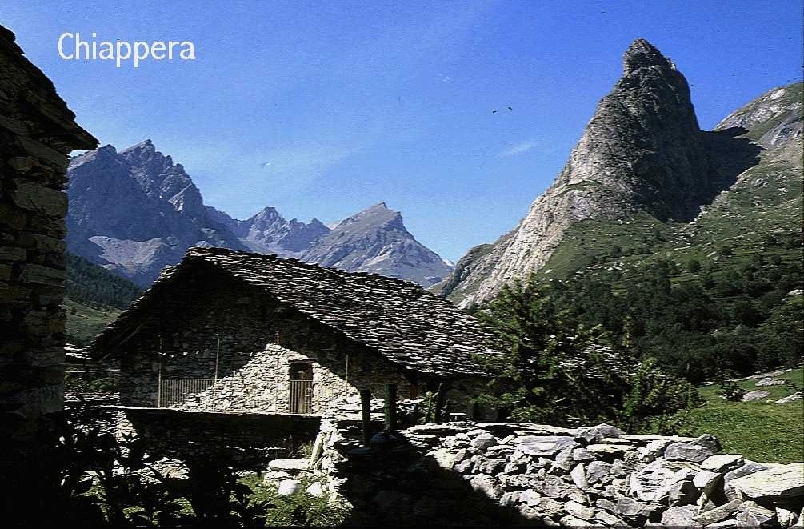


Piedmontese Grammar
Also in Piedmontese verbs can be transitive or intransitive, and the former can have an active, passive or reflexive form. Not all the verbs that are transitive in Italian or in English are transitive also in Piedmontese, and vice-versa.
In Piedmontese, as it is in Italian, there are three conjugations for verbs, and there are irregular verbs. Piedmontese has some particular irregularity with respect Italian. The structure of the verbal conjugations, in piedmontese, supposes the use of the two auxiliary verbs esse, avej that are to be, to have in english. These verbs, then, have its own meaning. The use of these auxiliary verbs is similar to the italian one, but in Piedmontese there is a greater use of the verb "avèj", for some intransitive verbs that in Italian require the auxiliary "essere" (to be). We will see in detail the piedmontese use of the auxiliary verbs.
A Piedmontese particularity is given by the verbal personal pronouns that we have already seen. We already told about the piedmontese tenses, and in particular we noticed the absence of the "perfect", and derived tenses, not in the grammar, but in the common use. We look here more in deep at forms, moods and tenses, and at the correspondence between Piedmontese and English.
Here you will find also the "perfect" and derived tenses, even if they are no more used, but they can be useful for reading old piedmontese writings and, in any case, they are always available for use (they are always part of the piedmontese grammar).
Another piedmontese particularity is the absence of the Present Participle. Where they are required, there are specific adjectives for the same purpose, that in Piedmontese are only adjectives, and not verbal voices. Otherwise specific locutions are used.
Very particular, in Piedmontese, are also the negative conjugations, interrogative coniugations, and the combinations of interrogation and negation. We will see them later
Finally we note that in Piedmontese there is a group of verbs that can be of two different conjugations, for all or for some voices. These verbs have two infinitives, one of the second and one of the third conjugation.
For each conjugation there are personal moods, and impersonal ones. Personal moods are Indicative, Subjunctive, Conditional, Imperative Impersonal moods are infinitive, Participle, Gerund. This is a scheme followed by all the neo-latin languages.
Meaning of Indicative tenses in active form:
Engl. Present tense: is simply translated into the piedmontese present, even if, in Piedmontese it is used also in some of the cases in which the English uses the continuous present.
Example: I go = Mi i vado
Engl. Continuous present tense: can be translated into piedm. present or in some forms of continuous present that in piedmontese can be expressed by:
Subject + pers. verb. pronoun, related voice of the present of esse (to be), the expression ancamin che, or mentre che, the pers. verb. pronoun related to the subject, the corresponding voice of the present of the main verb.
Example: I am going = Mi i son ancamin che i vado or Mi i son mentre che i vado or, simply Mi i vado.
Another way is the following:
Subject + pers. verb. pronoun, related voice of the present of sté (to stay) regularly conjugated, the present gerund of the main verb.
Example: I am going = Mi i stago andand. This second way is less used. This is close to the english form, but the used "auxiliary" verb (not considered as such in Piedmontese) is different.
Engl. Past tense: in piedmontese can be translated into two different tenses, according the idea supported by the verb. If the action was habitual or continuing, or taking place along a period of time, during the time period described by the sentence, then this tense is translated into the piedmontese imperfect (amperfét), otherwise it is translated into the piedmontese present perfect, which is a composite tense.
Examples: He went away while I was there = Chiel a l'é andàit via mentre mi i j'era lì
with the first voice at present perfect and the second at imperfect. The action of his going away was completed while the action of my staying was continuing.
When the described action happened in the past, in a completely ended time, and it was not continuous, the perfect can be used (the tense no more usually used nowadays), like in the case: Last week I went there = la sman-a passà i andero là even if the current form is: la sman-a passà i son andàit là.
Engl. Continuous past tense: is dealt in a way similar to the one seen for the continuous present by substituting all the present tense voices with imperfect tense voices. Often it is simply translated into the imperfect tense.
Examples: I was doing that = Mi i fasìa lòn or
Engl. Present perfect tense: is simply translated into the piedmontese present perfect tense that, of course, includes all the cases in which this tense is used in English.
Example: I have gone = Mi i son andait.
Engl. Present perfect continuous tense: is simply translated into the piedmontese present perfect tense or it can be translated sometimes with the present perfect of sté (to stay) instead of "to be", followed by a + infinitive of the main verb.
Example: I have been working here ... = Mi i son stàit a travajé sì ... or, also: mi i l'hai travajà sì.
Engl. Past perfect tense: is simply translated into the piedmontese past perfect (trapassà) tense, when "the past" expressed in the past, is an "imperfect", otherwise the piedmontese present perfect is still used, possibly associated to adverbs of time completing the meaning.
Examples: I was not there since I had gone away = Mi i j'era nen là vist che i j'era andàit via, but:
After I had gone he arrived = Dòp che i son andàit chiel a l'é rivà.
We note that here it is still allowed the use of the old "trapassà lontan", and the last sentence could be: Dòp che i fure andàit chiel a river.
Engl. Past perfect continuous tense: is translated like the present perfect contiuous, but using the contiuous past tense.
Example: After I had been working here ... = Dòp che mi i l'avìa travajà sì.
Engl. Future tense: is simply translated into the piedmontese future (futur).
Example: I will go = Mi i andrai.
Engl. Future continuous tense: uses the same english mechanism, made by the future of the verb stè (to stay) instead of "to be", and the present gerund of the main verb. Another way is to use the same expressions of the present continuous tense esse ancamin che..., esse mentre che... with the verb esse (= to be) conjugated at the future, with the main verb at the present.
Example: I will be travelling ... = Mi i starai viagiand ....
I will be travelling ... = Mi i sarai ancamin che i viagio or Mi i sarai mentre che i viagio.
Engl. Future perfect tense: is simply translated into the piedmontese future perfect (futur anterior).
Example: When I will have done it = Cand i l'avrai falo.
Engl. Future perfect continuous tense: is simply translated into the piedmontese future perfect (futur anterior) or it can be made by the future perfect of the verb sté (to stay) instead of "to be", followed by a + infinitive. There are not forms using "ancmin a" or "mentre che".
Example: You will have been studying for two years = ti it saras stàit a studié për doi ani.
You will have been studying for two years = ti it l'avras studià për doi ani.
Meaning of Subjunctive tenses in active form:
In Piedmontese the subjunctive is more differentiated from the indicative than in English, and it is always used in subjunctive sentences. There are four subjunctive tenses in piedmontese that are: present, imperfect, past (present perfect), past perfect (trapassà). We show the relationship between Piedmontese and English by means of examples, since this is not so direct. Very often, in Piedmontese, the subjunctive sentence is governed by the conjunction "che = that" or "për che = so that, so as" (in final clauses), etc.:
Piedm. Present tense:
It is necessary that we be on time = a l'é necessari che i sio 'n orari
I want that you go, I want you to go = Mi i veulo che ti it vade.
I tell it you so that you know it = I ët lo diso për ch'it lo sàpie.
What do you want (that) I tell you? = Còs veus-to che i ët disa?.
Piedm. Imperfect tense:
If I were you ... = Se mi i fussa ti ...,
I thaught that you were ready = Mi i l'hai pensà che ti it fusse pront.
I didn't think that they went = I pensava nen che lor a andèisso. I told it to them so that they knew it = I l'hai dijlo për ch'a lo savèisso.
Piedm. Past tense:
I think that he went yesterday = Mi i chërdo che chièl a sia andàit iér.
The imperfect tense contains the idea of an action or a status which was persistent: ( ... you were ready... ) or taking place in the same moment considered in the main sentence. The past tense is referred to an action completed in the present moment (present tense in the main sentence). The following past perfect has a similar meaning, but with the main sentence expessing a past moment or period.
Piedm. Past perfect tense:
I thaught that you had gone = Mi i pensava che ti it fusse andàit.
Meaning of Conditional tenses in active form:
There are two conditional tenses in piedmontese, with an own form, that are present and past. Their usage is similar to the english one. Often conditional forms are associated, in the sentence, to subjunctive ones. Usually, in these cases, the subjunctive sentence express a condition, and the conditional sentence express what happen (possibly) if the condition were true. As before we give some examples:
Engl. Present tense: The sentence expresses what would happen now if....
I would go, if you went = Mi i andrìa se ti it andèisse.
If it were so, I would be happy = Se a fussa parèj, i sarìa content.
Engl. Present continuous tense: as before uses the present conditional of the verb sté and the gerund of the main verb. Example:
I would be eating ... = Mi i starìa mangiand ....
Also in this case the present conditional of esse ancamin che .... or esse mentre che... can be used, followed by the present indicative of the main verb:
I would be eating ... if you weren't here = Mi i sarìa ancamin che i mangio, s'it fusse nen sì.
Engl. Past tense: : The sentence expresses what would have happened before (in the past) if....
I would have gone, but I couldn't = Mi i sarìa andàit, ma i l'hai nen podù.
I would have passed the exam, if I weren't wrong = I l'avrìa passà l'esam s'i fussa nen sbaliame
Engl. Past continuous tense: as before uses the past conditional of the verb sté a + infinitive of the main verb.
Example: I would have been playing ... = Mi i sarìa stàit a gieughe ....
Also in this case the past conditional of esse ancamin che .... or esse mentre che... can be used, followed by the imperfect indicative of the main verb:
I would have been playing ... = Mi i sarìs stàit ancamin che i gieugava ....
Meaning of Imperative tenses in active form:
There are two piedmontese imperative tenses that are present and future. They express a command that have to be executed now or in the future. We remember that with this mood the personal verbal pronouns are not used in the present tense, they are anyway used in the future tense.
Piedm. Present tense:
go away = va via ; he must go (as an order) = ch'a vada.
Piedm. Future tense:
you will have to go (as an order) = it andras.
Impersonal verbal moods and tenses in active form:
We consider the english infinitive, participle and gerund at the two tenses present and past that can be simple or continuous, their usage and the piedmontese correspondence, that is not direct in many cases. We mainly will make use of examples. At this point we d'better to recall that auxiliary verbs, in piedmontese are esse (to be), avej (to have). We will see later what are the verbs that make use of the first, and what are the verbs that make use of the second. Here we refer, in general, to an auxiliary verb.
Engl. Present infinitive: has some cases in which uses the to and other cases in which it is not used. In Piedmontese this problem does not exist. Its piedmontese translation is still usually into infinitive with some exceptions. Examples:
he must go = Chiel a deuv andé ;
I don't want to go = I veuj nen andé ;
I want you to go = Mi i veuj ch'it vade (subjunctive instead of infinitive).
Engl. Continuous present infinitive: it is translated by means of the verb sté at infinitive and the gerund of the main verb. Still we can use esse ancamin.. but for infinitive is not used the conjunction "che". It is instead used the preposition "a" and the infinitive of the main verb.
Example: to be drinking = sté bèivend. or essa ancamin a bèive.
Engl. Perfect infinitive: it is translated by using the infinitive of the auxiliary verb and the past participle of the main verb, as in English.
Examples: To have gone = esse andàit ; to have written = avej scrivù.
Engl. Continuous perfect infinitive: it is translated with the piedmontese perfect infinitive, or the sentences makes use of the past subjunctive of sté and gerund, or with perfect infinitive of the verb sté followed by a + infinitive of the main verb.
Examples: you must have been waiting ... = ti it deuve avej spetà ... = ti it deuve esse stàit a speté
you seemed to have been speaking = A smijava che ti it ëstèisse parland. (We note that literally the main sentence is impersonal It seemed that you ...., so the second sentence becomes subjunctive).
Engl. Present participle: in piedmontese it does not exist as such. We already saw how it is substituted in continuous forms of the verbs. An english usage is after verbs of movement or position, where is substituted in piedmontese by a + infinitive.
Example: You go shopping = Ti it vade a compré.
Another english usage is after verbs of perception + object, and in this case it is substituted by che + verbal voice of indicative.
Example: I hear you speaking = Mi i sento che it parle.
The english use as an adjective is substituted by "ad hoc" piedmontese adjectives.
Example: A boring thing = na còsa noiosa.
In other cases it is replaced by present gerund.
Example: Knowing that, he went = Savend lòn, a l'é andàit.
Engl. Past participle: is simply translated into piedmontese past participle, taking into account that often, in piedmontese, the past participle is not used as an adjective since a specific adjective exists that is different.
Example: You have broken my clock = Ti it l'has rompù mia mostra, but: My clock is broken = Mia mostra a l'é rota.
Engl. Present gerund: We have seen that in piedmontese the gerund is used for continuous tenses, then, in other cases, it is less used than in english, being often substituted by the infinitive. As a subject of a sentence, piedmontese uses the infinitive.
Example: Hunting is dangerous = Cassè a l'é pericolos.
Also after a preposition, where in english the gerund is used, piedmontese uses infinitive.
Example: Your way of doing this ... = Toa manera ëd fé sòn ... .
Then in piedmontese it is not used in compound nouns that have their own expression. The English use as a complement of the verb to be, is similar to the Piedmontese use, even if the piedmontese verb is usually sté.
Example: He is doing ... = Chiel a stà fasend ... .
We still report some examples:
She is good at painting = Chila a l'é brava a pituré (infinitive) ;
a flying lesson = na lession ëd vòl (noun)
Engl. Past gerund: the same usage apply as for the corresponding present. Both present and past gerund are used in causal clauses (as it happens in English, and in many languages)
Having known you, I could... = Avend conossù ti, i l'hai podù....

